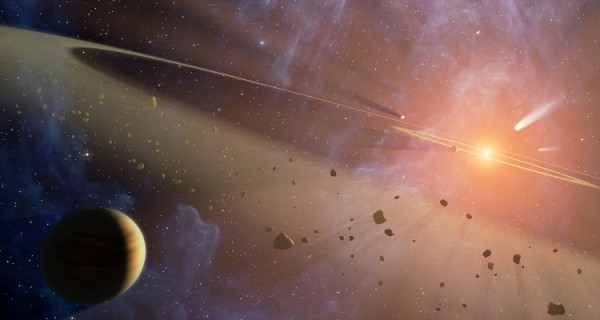New Horizons Spacecraft Almost Near Pluto; Hubble Finds Kuiper Belt Objects to Study
| Ana Verayo | | Oct 17, 2014 09:35 AM EDT |
(Photo : Wikimedia/NASA/JPL-Caltech) The Kuiper Belt is similar to an asteroid belt where it is larger in diameter and holds one billion icy objects
The New Horizons spacecraft will make its first encounter with three new Kuiper Belt objects as it journeys towards the ninth planet in the solar system, Pluto.
New Horizons was launched in January 19, 2006 with the primary mission of reaching the farthest planet in the system and further studying and observng the former exoplanet.
Like Us on Facebook
In February 2007, the spacecraft passed by Jupiter where it used Jupiter's gravitational forces as a slingshot to further propel New Horizons into deep space, making the voyage shorter by three years.
New Horizons is estimated to arrive near the distant planet's orbit by July 14, 2015 at 7:50 a.m. EDT as it is travelling at speeds of 33,000 miles per hour.
Pluto was declassified as part of the solar system by the International Astronomical Union (IAU) in 2006, although it was met with great criticism from the public. Last month, Owen Gingerich, chairman of the IAU planet definition committee, declared that Pluto is indeed a planet. However, there is no official statement reclassifying the planet.
As New Horizons rendezvous with Pluto, it will also encounter the Kuiper Belt which is located approximately 50 astronomical units from the sun and extends its orbit within Neptune and beyond.
Considered similar to an asteroid belt, it is a collection of frozen objects that are believed to be relics from the formation of the solar system some 4.6 billion years ago.
This is the first for humankind as no other spacecraft has visited this region in the outskirts of the solar system. The Kuiper Belt extends from 6.25 miles in diameter where objects could number as many as one million.
The Hubble Space Telescope was the first to detect these icy objects amassed in the Kuiper Belt's abyss. They will provide the opportunity for New Horizons to observe the region as it journeys towards Pluto.
At first, ground based telescopes have detected seven Kuiper Belt object but spacecrafts could not reach the belt because of its sheer distance.
According to John Spencer of the Southwest Research Institute, also part of the New Horizons team, it was worrying at first that the Hubble could not find any potential Kuiper Belt object for New Horizons to study closer but in the end, the telescope found some.
New Horizons will be able to further observe three objects where one can be reached by the spacecraft where the other two will still need further analysis. These objects ranges from 15 to 34 miles in diameter, rather tiny in size.
New Horizons will arrive at the belt, some one billion miles from Pluto's orbit, in 2018 or 2019.
TagsNew Horizons Spacecraft Almost Near Pluto; Hubble Finds Kuiper Belt Objects to Study, NASA, new horizons spacecraft, hubble telescope, kuiper belt, Pluto, new horizons pluto kuiper belt objects hubble
©2015 Chinatopix All rights reserved. Do not reproduce without permission
EDITOR'S PICKS
-

Did the Trump administration just announce plans for a trade war with ‘hostile’ China and Russia?
-

US Senate passes Taiwan travel bill slammed by China
-

As Yan Sihong’s family grieves, here are other Chinese students who went missing abroad. Some have never been found
-

Beijing blasts Western critics who ‘smear China’ with the term sharp power
-

China Envoy Seeks to Defuse Tensions With U.S. as a Trade War Brews
-

Singapore's Deputy PM Provides Bitcoin Vote of Confidence Amid China's Blanket Bans
-

China warns investors over risks in overseas virtual currency trading
-

Chinese government most trustworthy: survey
-

Kashima Antlers On Course For Back-To-Back Titles
MOST POPULAR
LATEST NEWS
Zhou Yongkang: China's Former Security Chief Sentenced to Life in Prison

China's former Chief of the Ministry of Public Security, Zhou Yongkang, has been given a life sentence after he was found guilty of abusing his office, bribery and deliberately ... Full Article
TRENDING STORY

China Pork Prices Expected to Stabilize As The Supplies Recover

Elephone P9000 Smartphone is now on Sale on Amazon India

There's a Big Chance Cliffhangers Won't Still Be Resolved When Grey's Anatomy Season 13 Returns

Supreme Court Ruled on Samsung vs Apple Dispute for Patent Infringement

Microsoft Surface Pro 5 Rumors and Release Date: What is the Latest?











